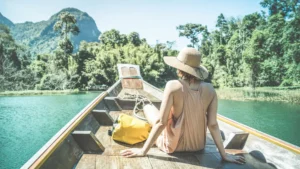The culture of the Iban—the aboriginal people of Sarawak—has always held a certain fascination with me. Once considered the fiercest and most stoic warriors of the Southeast Asian jungle, the Iban were renowned headhunters. They inspired fear into the hearts of any who tried to seize their land. And their intricate tattoos, woven blankets and dancing ceremonies documented the battles and number of kills. These days, however, the Iban are a peaceful and friendly society, with a rich, traditional culture that is still observed in modern times (minus the headhunting). To experience and understand the unique lifestyle of Borneo’s indigenous tribes, a longhouse homestay is highly recommended.
Years ago, when I lived in Kuala Lumpur, a friend organized an unofficial “homestay” in an Iban longhouse near to the Niah National Park in northern Sarawak. I jumped at the opportunity. Back then, as the homestay program wasn’t properly established, we simply brought food, clothes and other practical goods as gifts in exchange to stay in the communal longhouse. Nowadays, visitors can arrange to stay at the same longhouse or several others either through government or non-profit initiatives. We stayed at the Rumah Patrick Libau long house which is located only a 15-minute walk from the awe-inspiring Niah Caves.
What Is A Longhouse?
A longhouse, as the name implies, is a long, narrow building where an entire community resides. In Iban language it is referred to as Rumah Panjai, and is most commonly built on stilts off the ground and incorporates a large public area on one side with a row of private living quarters on the other. It could definitely be described as the most practical living solution for those inhabiting jungle areas: the elevated design ensures flooding is not a burden, that air is easily circulated and that livestock can be housed underneath. In Borneo, often old wood (sometimes teak) was used for the floorboards, bamboo for the pillars and roof, and elm bark for the roof thatching.
The Experience
These days many of the tribes try to supplement their incomes from traditional sources such as farming and fishing by hosting visitors at the longhouse. At Rumah Patrick Libau we not only stayed in the longhouse but participated in day-to-day activities. We learned how to process the rice from the paddy field in a traditional way, as well as witness first-hand how the locals make ‘Tuak’, a potent rice wine. Also, we learned how to trap fish with traditional traps made from bamboo and to cook ‘pansoh’ and cultural cakes inside the bamboo over an open fire. The women demonstrated the art of weaving ‘Betenun’, a unique Iban cloth that tells stories through symbols, while men shared the art of making the sword ‘Ngamboh’ and it’s sheath. Traditional tattoos are commonly seen on the men, particularly the older men. Those daring enough to get tattooed in this time-honored way can request it (even though it is a painstakingly long process to get tattooed in the traditional way, the design is truly special).
Besides the daytime activities, which included trekking into the virgin Niah rainforest, the nighttime festivities were the most fun. The Iban love a good party and we enjoyed some excellent local entertainment—the cultural dances and live music were complemented very well by the Tuak wine! In fact, the rice wine party is a normal event for visitors. The visitors (us) are generally expected to sponsor a party, which involves buying a number of Tuak bottles. The locals will drink as many as you buy. In our case, we bought 30 bottles and between a group of at least 30 (with some children and women who do not drink) we managed to polish them all off. Typical Iban dances—the Ngajat—were performed to a percussion group, or agung ensemble which included a xylophone-style instrument, gongs, tawak (bass) and another drum. The male dancers told rhythmic tales of ancient warfare, while the female routines were graceful and romantic.
Exploring Niah National Park
There’s simply no better way to explore the jungle than with a local and our local guide made the longhouse experience all the more special. The Niah National Park may not be Sarawak’s biggest, but it is certainly one of its most significant, with evidence that people have inhabited the caves for up to 40,000 years. In fact, the earliest modern human remains ever discovered in Southeast Asia were found here, making it one of the world’s most important archaeological sites. It is not far from the longhouse, with the ‘Great Cave’ and ‘Painted Cave’ accessible via plankwalk through the lowland forest.
While the ‘Great Cave’ no longer harbors human residents, the Iban still collect guano (bird and bat droppings for fertilizer) and bird’s nest for consumption. We were intrigued, but declined to participate in this odorous activity. Besides the ‘Great Cave’, there is the aptly named ‘Painted Cave’ which is famous for paintings of human figures depicted in red rock ink. The humans in the paintings are watching over a gravesite of boat-shaped coffins.
Around the caves, the jungle is vibrant and lush. Giant tapang trees with large roots, pandanus plants, orchids and pitcher jugs are a common sight. Traverse quietly and you may witness monkeys as well as flying lizards and the occasional hornbill. The outside of the caves is also a grand sight—limestone stalactites and other strange rock formations, which are eerily juxtaposed with bright green creepers dangling over the caves’ mouth.







